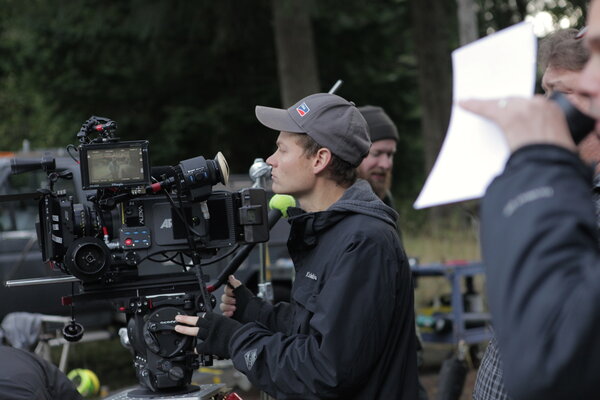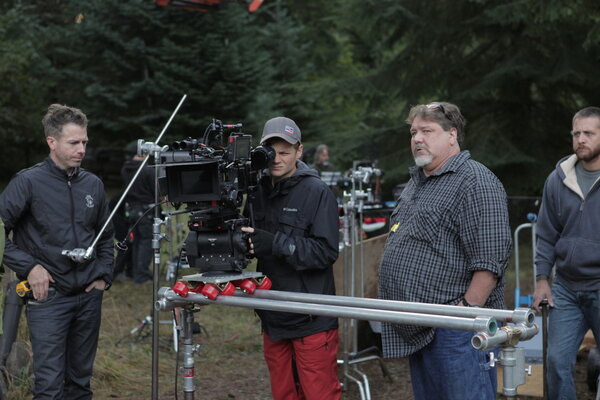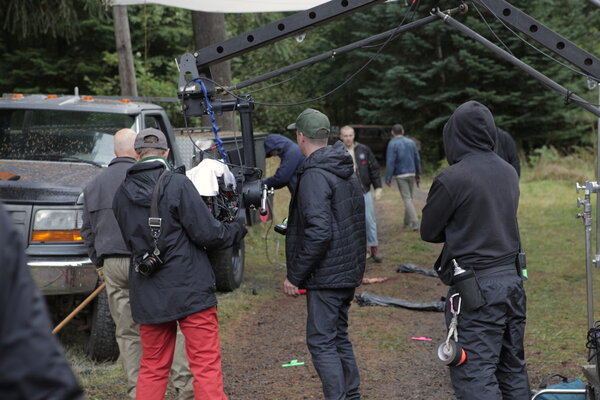Cinematographer Sean Porter discusses his work on Jeremy Saulnier’s film "Green Room"
Punks against Dogs
How did you come to work on this highly anticipated film ?
Sean Porter : Green Room is a film produced with a budget that had nothing to do with that of Blue Ruin. This is a much higher budget production and producers’ expectations of course are consequently much greater. I think a lot of directors like Jeremy, being put at the head of a large production for the first time, might have hired a big-name Hollywood cinematographer to create the visuals for his movie… But not him.
Since he himself has worked on many independent productions as a cinematographer, I think that he wanted to keep that atmosphere of simplicity on set and in his style of directing. In addition, we discovered that we know many people in common, like Michael Tully, for whom I was going to shoot a movie in 2011, but Jeremy replaced me on that project… All of those things made it easy for us to get along from the start, once we had been put into contact by our agents.
And by the way, what is a "Green Room" ?
SP : A "Green Room" in the US is a room backstage that musicians can use to prepare before a concert or rest after it. But the room doesn’t have to be painted green ! In the film, ours is painted grey with rather cold tones. That set, along with everything else in the second half of the film, was recreated in studio, where we filmed almost half of the film.
What were the major challenges facing you as you tried to create this film ?
SP : Actually, the film is a lot like Blue Ruin from a certain point of view, because it is sort of bipolar. It begins like a light-hearted road trip, which we filmed on location in Oregon, with warm light and a carefree feeling, but then takes a much darker turn with deep colours in the second half of the film.
At the outset, I was a little worried because the script was quite strong in terms of violence and gore, but my fears were dissipated when I realized how intelligent and relevant Jeremy’s approach was. A bit like in Alice in Wonderland where you suddenly find yourself on the other side of the looking glass.

Did shooting last for a long time ?
SP : Thirty-three days between October and November 2014, which, given the number of characters in the film, wasn’t a luxury. You know, when you find yourself setting up scenes all day long with seven people at the same time in a room in a van, it takes you a huge amount of time. Especially since we were only filming with one camera.
And then there are all those scenes with the Skinheads’ dogs that took us a while to make, with all of the special effects done on set using “puppets” and trained dogs. There were very few digital effects except for a few additions here and there, as has now become standard practice, in order to perfect the reality.
What were your artistic choices in terms of the image ?
SP : Rather than diving into a shoulder camera, we decided that filming this rather chilling story with a fixed camera would better capture the actors in a closed space and would be more relevant. But nonetheless, Jeremy still wanted to use some camera movements in his choices as a director. The Steadicam was eschewed in favour of a dolly, as we wanted the movements to feel slightly imperfect. Like on films from the 1970s, in the travelling shots you can sometimes see a bump in the image when the dolly hits the place where two pairs of rails meet !
We also often used a vintage crane prototype, the "Zero Gravity Arm", which is an invention of Innovision Optics allowing the camera to hang like a pendulum, and then to use it like a shoulder camera as you move around. This poor-man’s Technocrane is very useful for rapidly executing camera movements, while keeping the feel of a dolly in terms of the image.

Did you do camera tests ?
SP : Yes, the producers granted me quite a bit of latitude so I could do a lot of tests. I know that the vast majority of productions are now filmed with the Arri Alexa, but I still want to do comparison tests, especially with the Red Dragon, which I also really like. At the end of its tests, the Alexa was chosen due to its greater flexibility in terms of use, including the ability to push it to its limits - something that becomes very dangerous when filming with Red. I was able to test makeup, costumes, the colour tones of some of the sets, sometimes with filters, and I uploaded them all to a server online that could be accessed by all of the various departments. That was something that became really useful as filming began.
What kind of filters did you use ?
SP : I used rather dense coloured filters… "Dark Blue” or "Tobacco" for example. I even used both at once on some shots ! The idea was to later push the Alexa’s signal in order to return to almost-natural colours in order to create a structure of the image that would have been impossible to obtain if we had started off with unfiltered shots.
Did you shoot using Raw ?
SP : No, we shot in ProRes. The Alexa’s Log C is really excellent, and I think the added cost and extra weight of Raw were not at all needed. For the car scenes, I also used the Alexa M, which was our second camera for times where we did not have much space.
But I’m not convinced by this camera and its remote recorder. I’m eagerly awaiting the new Alexa Mini that has just been announced, and which I think will perfectly fit the bill for my next films. In terms of sensitivity, the camera was set to 800, but in reality I use it higher by setting my cell to 1600. I do that in order to push the signal a bit and distort the result of digital cinematography, which is much too clean for my taste.
What about the lenses ?
SP : I also tested out a lot of lenses, and like Jeremy, we’re fans of older lenses. We used a Cooke S2 series for the entire film, complemented with an Angénieux zoom lens for a very few shots.
This is where you realize that filming with a fellow cinematographer in the role of director is quite exhilarating. You can understand each other instantaneously, and you don’t have to explain the difference between a 32mm and a 40mm on set ! Things move fast, and you don’t waste time setting up each shot because the director directs the actors in a way that accounts for the lighting and a lot of parameters relating to the image that can be compromised by the way a complex shot is set up.
What was your strategy for the lighting ?
SP : Although we shot in studio, I tried to light each scene as though we were indoors with natural light. We did this by using light sources located outside of the windows or, at night time, by using as much light as possible from prop sources, with the help of the production designer.
We could almost film from all 360 degrees without having to use spots, and everything was completely controllable from the lighting board. That’s kind of the advantage of shooting in studio. But in any case, the lighting on the film is very natural, because we didn’t want the film to feel like there were any special effects.
Do you ever miss filming in 35mm ?
SP : was lucky enough to have had the opportunity of filming a lot of movies in 35mm film. But what I’ve realized over the years, and what I find a bit ironic about this subject, is that when you use 35mm film, you never know exactly what you’re going to get after development and scanning. But in 90% of the cases, when I discovered the images, they went beyond my expectations.
In digital, you have the results right away, and provided you use a properly calibrated reference monitor, we know pretty much for sure on set whether or not we’ve achieved our goals. And then the months go by, the film is cut and then goes to colour timing… And there, in 90% of cases, you suddenly realize that it wasn’t as good as you’d thought it was ! You notice that the colours are off… and then you begin to hesitate !
On that topic, I have a funny story from colour timing of Green Room : we worked with my usual colour timer Will Cox, of Final Frame. We’d almost reached the end of the film, we do one last review for any last minute changes… and then I notice something that really bugs me but that I can’t quite put my finger on. But then I suddenly realize that there is a computer monitor showing the film at the same time as the reference monitor.
And I think to myself, damn ! Those scenes look better on the computer monitor than on the reference monitor ! At the time, I didn’t dare say anything to anyone… I was afraid of sounding ridiculous. And then, that night, at home, I thought it over. Wracked by regret, I send an email to Jeremy and Will to tell them what I’d noticed. I did well, because we met the next day and in the end we agreed to take inspiration from the visuals on that little monitor in order to correct the film !
(Interview conducted by François Reumont for the AFC, translated from French by Alex Raiffe)
 En
En Fr
Fr





